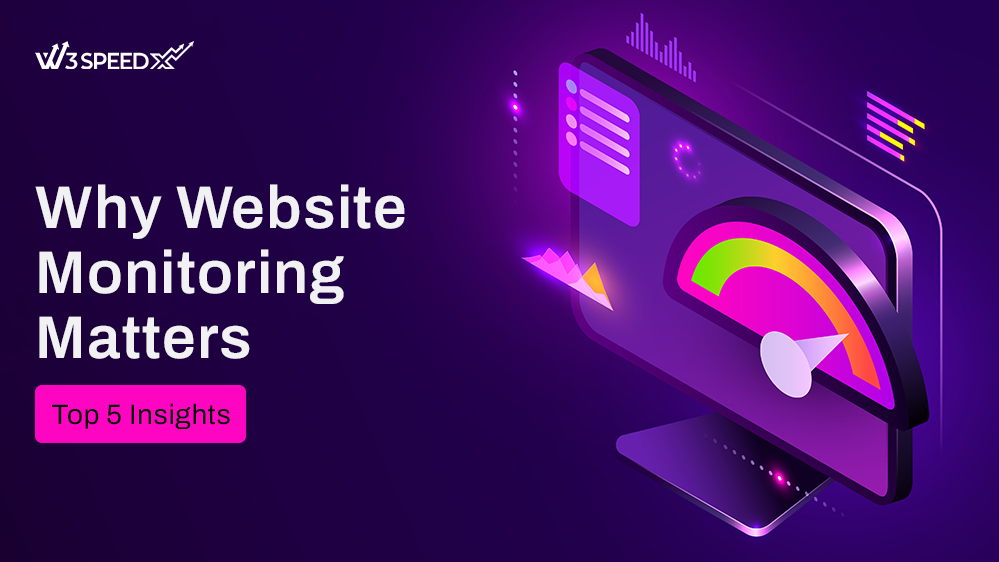You create a website to expand your business, reach more individuals, and establish a solid online presence. But what if it is not available when someone visits it? What if it takes too long to load or breaks without you knowing? You lose that visitor. You lose trust. You even lose sales. And it all occurs suddenly and in silence.
Your website runs your brand 24/7, even when you and your employees sleep. So why wouldn’t you keep an eye on it all the time? Or are you from a group of people who wait until something breaks before taking action? Well, that’s not smart. Even you know that’s risky.
This is where website monitoring helps you know the moment something goes wrong, so you can fix it fast, before your customers even notice.
So, let’s understand more about the benefits of regularly tracking your web pages through this blog.
What is Website Monitoring?
Website monitoring entails keeping track of everything your website does, every second. It checks if your website is working, how fast it loads, and how well each part is running. It shows you if your website is online, if users can open pages, click buttons, and complete actions like reading content or making a payment.
This process doesn’t happen just once, it keeps happening nonstop, all day and night. Because anything can go wrong, your site can slow down, break down, or even stop working, obviously without prior notice.
However, with website monitoring, you find out right away, often before your users even notice. That way, you are in a space to fix issues fast and keep your site running smoothly.
What Can Website Monitoring Track?
If you think your website will take care of itself, think again. Monitoring is not a choice anymore, it is a must. It watches the parts that really matter and affect your growth. Here are five key things it tracks for you:
1. Speed Performance Tracking
The way your website loads says everything about your brand. Website performance monitoring evaluates how quickly your website responds when a person clicks, scrolls, or loads data. It also monitors major Core Web Vitals such as LCP, FID, and CLS metrics that have direct impacts on your SEO rankings. You get to see what slows your site down, including third-party scripts or large images. Plus, it monitors real user experiences across devices and locations to help you fix delays, boost speed, and improve both rankings and satisfaction.
2. Real User Experience Tracking
Real user experience tracking shows how people actually interact with your site, not just where they click, but how they scroll, move, and respond to your content. It reveals confusion points, drop-offs, rage clicks, and pauses that hurt your conversions. You see which sections get attention and which get ignored.
3. API Monitoring
APIs are behind-the-scenes tools that let your website talk to other services, like payment systems, maps, login tools, or product databases. If even one slows down or fails, your whole site can act up. API activity tracking checks each one constantly. It tracks response time, failure rates, and uptime so your features work exactly as expected.
4. Security Breaches
It happens when someone gets into your website or data without permission. It could be a hacker, a harmful script, or even a simple coding flaw. Website monitoring warns you about broken safety measures or accessible data.
5. Uptime and Downtime
Uptime means your website is live and working, and downtime is just the opposite. Even a few minutes offline can lead to lost visitors, sales, or trust. But with Site monitoring, you can check from multiple locations to confirm if your site is truly down or just slow in one area.
Why Website Performance Monitoring is Non-Negotiable?
Speed, security, and smooth performance are not bonuses, they are expectations. People visit your website looking for instant answers, fast actions, and a flawless experience. If you can not give them that, they move on without thinking twice. That’s why monitoring is not just about fixing problems, but rather it is about staying in control before those problems happen.
In the next few points, you will see how monitoring helps you move faster:
1. Supercharge Page Speed for Better UX & SEO
Speed decides what happens next. It decides if someone stays or leaves, if your page gets seen or ignored. Search engines measure how fast your page shows up, how it responds when someone clicks, and how long it takes before anything becomes useful on the screen. These tiny delays are recorded and affect how high your page shows in search results.
Page speed makes the difference between smooth and frustrating. And this is where monitoring helps you stay aware of every second, every change, and every factor slowing your site down. When you fix those, your users stay longer, search engines rank you higher, and your website performs like it’s meant to.
That’s why using a dedicated tool like W3SpeedX makes all the difference. It monitors your website’s Core Web Vitals daily, sends instant score drop alerts, and stores data for up to three months. You can track performance trends and identify areas for improvement with this smart tool. This consistent monitoring helps you maintain optimal site speed and user experience.
2. Protect Your Reputation and Revenue
A broken form, a missing image, or an error message can shake your credibility. It sends the message to the visitor that something is off. They will doubt your service, question your quality, and click away without a second thought.
But if you monitor your website health daily, you can easily catch things like JavaScript errors, failed pop-ups, or non-working buttons, all the things that quietly damage user confidence. Website monitoring alerts you about these issues before they hurt you.
So, you do not have to find out through a complaint. You already know, and you have already taken action. That is how you stay one step ahead of bad reviews and lost trust. Or I say that’s how you protect not just your image but also your income.
3. Save Time and Respond Instantly
Every second matters when something goes wrong on your website. A delay in spotting the issue often leads to a delay in fixing it, and as we discussed, that delay costs you visitors, trust, and even sales.
Regular website monitoring saves you from this chaos, which means you don’t waste time figuring out what went wrong or when it started. Because you saw it happening right in front of your eyes, and you began fixing it right away.
That is how site health tracking turns minutes into moments and keeps your business running smoothly.
4. Strengthen Security with Early Threat Detection
Website attacks don’t knock before entering. They slip in quietly through weak passwords, outdated plugins, or unnoticed loopholes. By the time you realize it, the damage has already been done with data leaks, broken trust, and a tarnished reputation, which is tough to fix.
But when you consistently monitor your website, you don’t deal with these issues more often. And when you do, you tend to spot suspicious activity the moment it happens, like a strange login attempt, a sudden code change, or unauthorized access.
So, it is natural for you to act early in this situation compared to those who don’t watch out for their site. You can easily patch up weaknesses, tighten access, and secure sensitive data before it is too late.
And as you know, in today’s digital world, staying passive is risky. But staying alert? That is how you stay safe.
5. Ensure a Smooth, Consistent Experience Across Devices
A flawless website on desktop means nothing if it breaks on mobile. And these days, most of your visitors are coming from their phones. If your site lags, scrolls weirdly, or refuses to load properly on smaller screens, you have already lost them, without even knowing it.
But when you monitor how your site performs across devices, you spot these problems the moment they show up. You see if a button misbehaves on mobile, if images don’t resize, or if a layout breaks on a tablet. Now you are not assuming that everything is fine; you are making sure that everything stays fine. And this approach changes everything for your site.
Because now that you are not waiting for criticism, rather fixing them, this makes every click, swipe, and scroll feel smooth on your site, no matter the device.
And when users feel good using your site, they stay longer, come back more often, and trust you more. That is not just good UX, it’s good for business too.
Final Words
Website monitoring is about watching for problems, recognizing patterns, learning from data, and making smarter decisions. The longer you monitor, the more insight you gain. You start to see which pages need redesign, what time users drop off, or how traffic shifts after a campaign. This turns your website into more than just a marketing tool; it becomes a source of intelligence.
The brands that succeed online are those that prevent issues, understand behavior, adapt, and fix problems quickly. And that is what you need to do with monitoring. Tools like W3SpeedX make this shift easier by keeping an eye on your site every day. So, you don’t have to check anything, as if something drops, it will alert you. This allows you to resolve concerns on the spot and move forward with your expansion objectives.


